Lightspeed vs Shopify: An In-depth Comparison of POS Systems
This most up-to-date comparison will delve into the key features, pricing, ease of use, integrations, and more of Lightspeed POS vs Shopify POS. Thus, we’ll help you make an informed decision about which point-of-sale system best suits your business requirements.
| Key takeaways |
|---|
|
Lightspeed vs Shopify: The Key Difference
Shopify originated as an e-commerce platform and has seamlessly integrated POS features. This makes it an ideal choice if you have a substantial online presence or plan to expand online. Lightspeed, on the other hand, started as a POS system with e-commerce features added later, so its strength lies more in physical retail.
Lightspeed POS vs Shopify POS: Pros and Cons
Both Lightspeed and Shopify have their strengths and weaknesses.
Lightspeed POS Pros and Cons
Pros
- Advanced inventory management
- In-depth reporting and analytics
Cons
- A more expensive POS system than many other alternatives
- A potentially complex user interface for beginners
- Required annual contracts for all the main pricing plans
Shopify POS Pros and Cons
Pros
- Seamless integration of online and offline sales
- User-friendly interface
- A wide array of integrations
Cons
- More ecommerce-focused
Lightspeed vs Shopify POS: In-depth Comparison
Software Costs
Lightspeed POS Pricing Plans
Lightspeed Subscription fees
Lightspeed offers four pricing tiers, each offering a unique set of features to cater to different business needs.
- Lightspeed POS Lean: $69/month. This plan has only some basic POS features.
- Lightspeed POS Standard: $119/month. The standard plan builds upon the Lean plan by offering additional features like accounting and ecommerce.
- Lightspeed POS Advanced: $199/month. This plan includes advanced features like omnichannel capabilities and advanced reporting.
- Lightspeed POS Enterprise: Custom. The enterprise plan offers the most comprehensive set of features, including all the features available on the other plans, plus more advanced features.
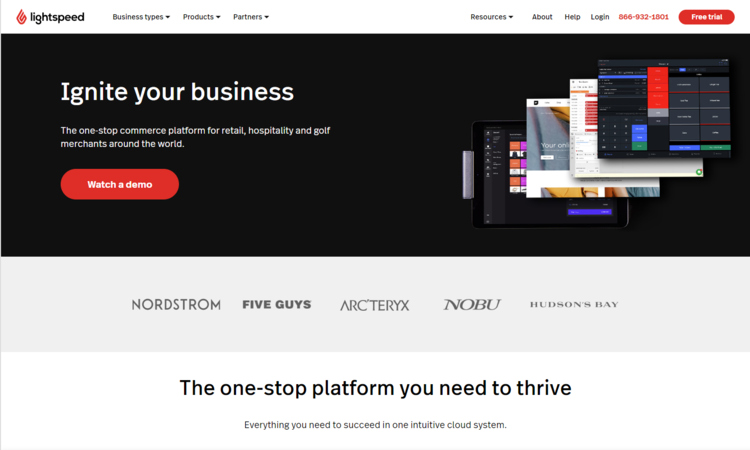
Lightspeed transaction fees
Lightspeed’s approach to transaction fees is pretty straightforward.
If you use Lightspeed Payments, their in-house payment option, for every transaction where a customer uses their credit card in person, the fee is 2.6%+ 10 cents. For transactions where the customer’s card isn’t physically present (like online sales), the fee is slightly higher at 2.9% + 30 cents per transaction.
If you use a third-party payment gateway (other than Lightspeed Payments), the fees are definitely higher than that.
Shopify POS Pricing Plans
Shopify POS Subscription fees
Shopify also offers various pricing plans designed to cater to different business sizes and needs.
- Shopify POS Lite: Free. The Lite plan includes basic POS features such as barcode support and order management.
- Shopify POS Pro: $89/month. The Pro plan includes advanced POS features like store management, staff roles, and reporting.
The good point is that Shopify POS gives you the freedom to choose whether to pay by month or by year.
You can save 10% of the cost for Shopify POS Pro —there’s only $79 left if you pay a Shopify POS Pro plan yearly.

However, you must be on one of the Shopify plans to use Shopify POS. The cheapest Shopify plan with a free POS feature costs you $39 per month.
For just $39 a month, you can set up your own ecommerce store and use point-of-sale (POS) features on Shopify. This starting cost is lower compared to Lightspeed Retail. Also, Shopify POS Pro, which only costs $20 more than Lightspeed’s cheapest plan, includes advanced features that you’d normally find in Lightspeed’s more expensive tiers.
Another thing to consider is the ability to add registers. Lightspeed charges an additional fee for each extra register, which can significantly inflate costs for larger businesses or those looking to expand. On the other hand, Shopify POS offers the flexibility to add an unlimited number of registers at no extra cost, providing a more scalable solution for growing businesses.
Shopify Transaction Fees
Shopify has a tiered pricing model, and the transaction fees vary depending on the plan you choose:
- Shopify Basic: 2.7% for in-person transactions.
- Shopify Plan: 2.5% for in-person transactions.
- Advanced Shopify: 2.4% for in-person transactions
It’s important to note that these fees apply if you use Shopify Payments, Shopify’s integrated payment system. If you choose to use an external payment gateway, there’s an additional fee, which varies from 2% (Basic Shopify), 1% (Shopify Plan), and 0.5% (Advanced Shopify).

Since Lightspeed doesn’t publicly disclose the transaction fees for using a third-party payment gateway, based on the transaction fees charged by their in-house gateway, we can assume that their fees are not lower than those of Shopify POS.
Hardware Cost
Lightspeed POS Hardware
Lightspeed offers a variety of hardware options, each tailored to specific types of businesses, such as retail, restaurants, or golf clubs. They sell bundles as well as individual hardware components. However, Lightspeed Retail doesn’t disclose the hardware costs, so you could expect it would be quote-based.
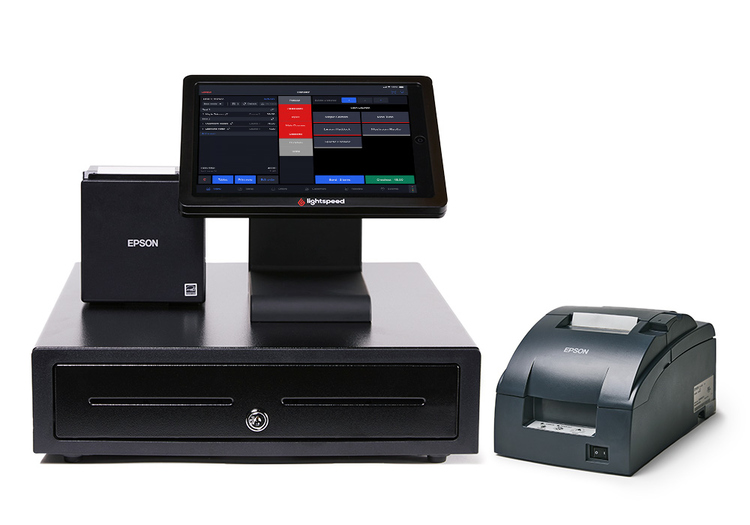
It’s important to note that you can integrate Lightspeed with your existing devices. However, they must be compatible with Lightspeed’s specifications.
Shopify POS Hardware
Shopify’s approach to hardware is quite flexible. They offer hardware kits, but you also have the option to purchase individual items to suit your specific needs.
For instance, the Shopify Retail Kit 9.7”, designed for brick-and-mortar stores, is priced at $219. This kit includes a tap and chip card reader, a dock for tap and chip reader, an iPad stand, and a mounting kit. You can download a tap-to-pay app - a mobile POS - on your iPhone for free.

Like Lightspeed Retail, Shopify POS is also compatible with a variety of third-party hardware, providing you with the flexibility to use existing hardware if you have any.
The verdict
Shopify is the winner as it tends to be more affordable than Lightspeed.
Sales Features
As two leading POS systems, Lightspeed and Shopify POS provide pretty similar robust sales features that can help drive your business growth. These features includes:
- Multichannel Sales: Shopify POS provides options like local pickup, buy in store & ship to customers, and local delivery from their system. On the other hand, Lightspeed offers real-time inventory visibility across all locations, seamless stock transfer between stores, and multi-location pricing customization, which is also available on Shopify.
- Payment Flexibility: Shopify POS enables split payments, partial payments, and custom payment types, while Lightspeed offers a similar range of flexibility with features like deposits/laybys/buy now pay later, on-account sales, and split payments. Both systems are integrated with popular payment methods such as Visa, Mastercard, Apple Pay, and Google Pay.
- Customer Engagement: Shopify POS has rich customer profiles and marketing preferences. Lightspeed Retail, on the other hand, allows you to add notes to customer profiles, helping you to keep track of specific customer preferences or requests.
- Discounts and Promotions: Lightspeed has a slight edge when it comes to promotions. While both systems allow you to apply custom discounts, Lightspeed also supports automatic discounts. This feature enables you to run promotions where the correct discount is automatically applied to the right products and customers every time.
- Sales Processing: Lightspeed and Shopify POS both provide robust sales processing features. Shopify POS comes with a customizable smart grid that speeds up the checkout process, and custom printed receipts. Lightspeed, on the other hand, offers barcode scanning for quick sales processing, service sales tracking, and customizable and gift receipts.
Overall, both Shopify and Lightspeed offer pretty similar POS features and functionalities, which are the key to your business success. However, Shopify takes some steps further by offering features that Lightspeed doesn’t, such as:
- Local delivery
- Email an in-store cart to a customer
- Product recommendations
- One-click online checkout
- Online marketplace sales (Google, Amazon, and more)
- Unlimited registers
Shopify vs Lightspeed: Restricted products
Shopify’s Restricted Products
Shopify has a list of items that it classifies as restricted, which primarily includes age-restricted products like alcohol, CBD products, tobacco, and anything that falls under the ‘sex and sensuality’ umbrella.
Lightspeed’s Restricted Products
Lightspeed offers a somewhat more lenient approach to high-risk sales, particularly for in-person transactions. The platform permits the sale of age-restricted products like alcohol, tobacco, and vape items. However, there’s a condition to this permission: you’ll need to acquire a supported 2D scanner to facilitate the sale of these items. This requirement ensures compliance with age verification laws and promotes responsible selling practices.
If your business revolves around selling high-risk products, these restrictions might pose a significant hurdle. However, don’t despair. There are payment processors out there that fully support the sale of high-risk items, and finding the right one can make all the difference.
The verdict: Which has better sales features?
Shopify is the winner as it offers some exclusive sales features.
Inventory Features
Both Shopify POS and Lightspeed POS offer a range of features to help manage inventory efficiently.
- Purchase Orders: Both Shopify POS and Lightspeed POS allow users to create purchase orders for vendors and suppliers. This is a critical feature that helps keep inventory levels optimal.
- Stock Management: Shopify POS offers a feature called stock adjustments, which enables tracking of small changes to stock levels. Lightspeed POS has a similar feature, stock counts, which helps maintain accurate stock levels through simple workflows to count and update inventory.
- Product Variations and Bundles: Lightspeed POS stands out with its ability to handle complex product variations with ease and bundle products while maintaining accurate inventory and margins. Shopify POS, on the other hand, does not offer a similar feature.
- Stock Transfers: Both platforms provide stock transfer features. Shopify POS allows users to request transfers from other locations, keeping track of what’s received and what’s leaving. Similarly, Lightspeed POS enables easy transfer of stock between locations to maximize sales and minimize surplus stock.
- Mobile Inventory Management: Lightspeed POS offers a mobile scanner app that lets users check stock levels, count stock, and update inventory from the shop floor. Shopify POS, on the other hand, provides a feature called inventory receiving, which allows users to perform accurate inventory counts for incoming orders using a barcode scanner.
Inventory: The verdict
Lightspeed is the winner as it offers advanced stock management features.
Reporting and Analytics
Both Shopify POS and Lightspeed POS offer a variety of reporting and analytics tools to help businesses make data-driven decisions.
- Sales Reports: Shopify POS offers retail sales reports, enabling users to analyze and export sales data by staff members, location, time period, or customers. Similarly, Lightspeed provides insights into your online store and register performance, channel performance, and employee performance.
- Product and Inventory Reports: Shopify’s product reports help users understand which products are selling and which are not. This feature aligns closely with Lightspeed’s product performance reports. Both platforms also offer inventory reports, providing insights into what needs to be replenished or not reordered.
- Discount and Promotion Reports: Both platforms provide discount reports, allowing businesses to track and monitor the usage of discounts. Lightspeed goes a step further by offering promotion performance reports, helping users understand which promotions are working best.

However, Lightspeed gains the upper hand by offering 40+ types of reports, making it a very comprehensive system for reporting and analytics. However, Shopify’s reporting capabilities can be enhanced through integrations.
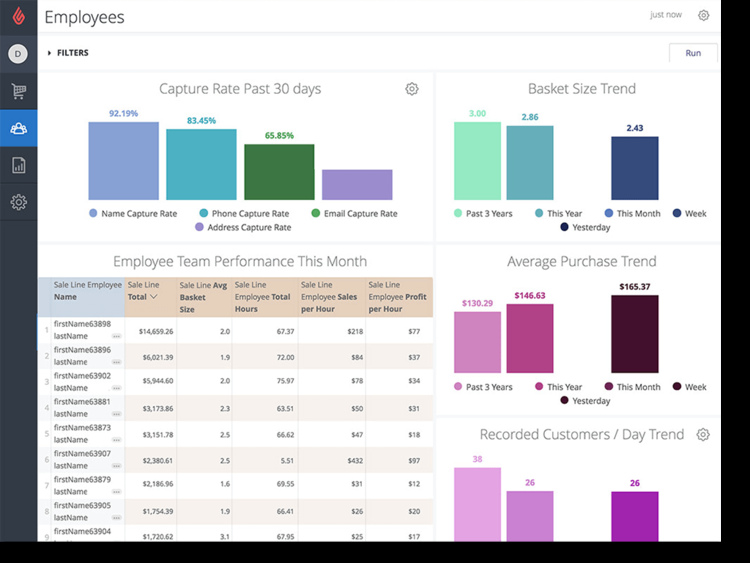
The verdict: Which has more advanced reporting capabilities?
Lightspeed may have a slight edge due to its more comprehensive analytics out of the box.
Apps and Add-Ons
With over 8000 apps in its app store, Shopify excels in terms of integrations, offering a wide array of add-ons. This allows businesses to easily enhance their system with extra features like email marketing or SEO tools. Lightspeed also offers add-ons, but the selection is less extensive than Shopify’s.
The verdict:
Shopify is the winner as it has a more extensive library of apps.
POS Hardware
Two leading POS systems, Shopify POS and Lightspeed POS, have pretty similar hardware systems.
Both Shopify POS and Lightspeed encourage you to use their branded hardware kits as they ensure more seamless integration and synchronization. However, they do give you the freedom to integrate with your existing devices as long as your devices are compatible with both brands’ specifications.

However, while Lightspeed doesn’t disclose the quote of their hardware devices, Shopify makes it clear and offers some free apps on the phone for POS users to save costs. This definitely gains a point to me.
The verdict
Shopify is the winner in terms of hardware choices.
Ease of Use
Shopify POS Ease of Use
Shopify is renowned for its intuitive user interface and ease of use, and its POS system is no different. The system is designed with a simple, clean layout that’s easy to navigate, even for first-time users as follows:
Setup and Onboarding:
Shopify provides a comprehensive guide to help users set up their POS system. This includes steps on how to add products, set up hardware, and customize settings. The setup process is straightforward and doesn’t require any technical knowledge.
Meanwhile, Lightspeed offers a thorough onboarding process. New users receive personalized, one-on-one training sessions to help set up the system and understand its features.
User Interface:
Shopify POS has an intuitive interface with a clean design. The main dashboard offers a clear overview of sales, orders, and customer data. Navigation is seamless, with easily accessible menus and quick links.
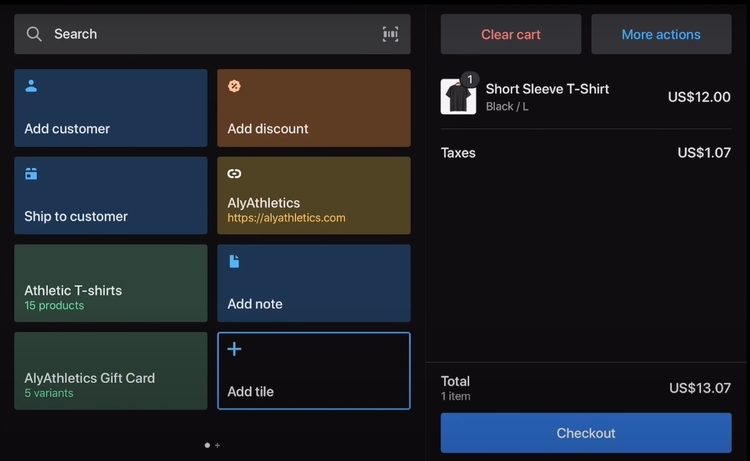
Lightspeed’s interface is clean and functional, with a focus on providing detailed insights. It may take some time for new users to familiarize themselves with the range of features available, but the overall navigation is intuitive.
Training and Support:
Shopify offers a wealth of resources for training and support, including online tutorials, webinars, and 24/7 customer support. Users can also access the Shopify Community to engage with other Shopify users and experts. Lightspeed provides extensive resources for free training and support, including how-to videos, webinars, and guides. Users can also access 24/7 customer support for any assistance they might need.
Integration with Shopify Ecommerce:
For businesses that also operate online, Shopify POS integrates seamlessly with Shopify’s ecommerce platform. This allows for unified inventory management, customer data, and sales reports across both platforms.

In the meantime, Lightspeed POS integrates well with Lightspeed’s ecommerce platform, allowing for multi-channel retailing. This provides a unified system for managing inventory, sales, and customer data across online and offline channels.
While both Shopify POS and Lightspeed POS prioritize user-friendly experiences, they cater to slightly different needs. Shopify POS stands out for its simplicity and seamless integration with its ecommerce platform, making it an excellent choice for small to medium-sized businesses or those who are new to using a POS system.
Lightspeed, while robust, has a steeper learning curve. Its advanced features can be complex, and some users find the interface less intuitive than Shopify’s. It may take a bit more time to learn, but the comprehensive capabilities can be a significant advantage for larger retailers or those with specific operational needs.
The verdict: Which is Easier to Use?
Shopify is easier to use as it has a more user-friendly, intuitive interface, making it easy for even beginners to set up and manage their online store.
Apps and integrations
Lightspeed Integrations
Lightspeed offers a range of integrations with other business tools, including accounting software like QuickBooks, marketing tools like Mailchimp, and reservation platforms like OpenTable. These integrations can extend the functionality of the Lightspeed system, but the selection is less extensive than Shopify’s.
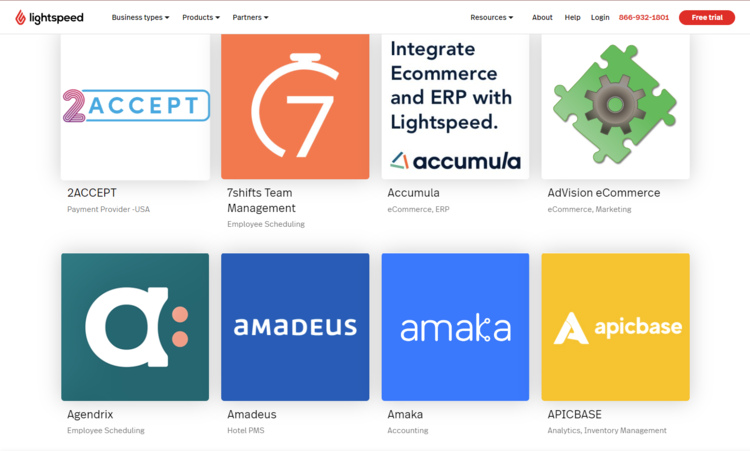
Shopify Integrations
Shopify offers a wide array of integrations through its app store. Businesses can add features like email marketing, SEO tools, and customer loyalty programs to their Shopify system. This flexibility allows businesses to customize their Shopify system to meet their unique needs.
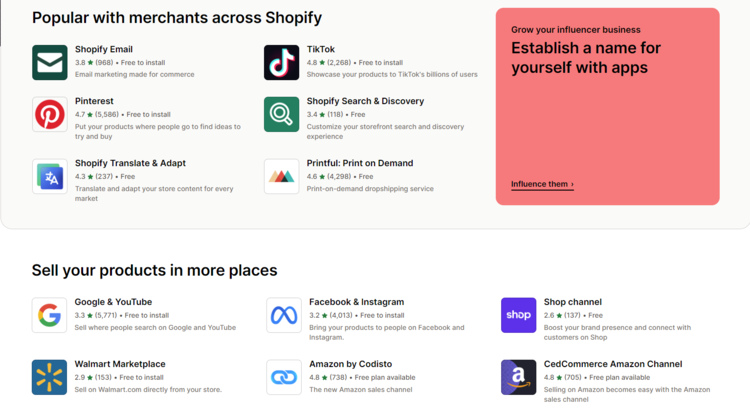
The verdict: Which has a larger library of apps and integrations?
Shopify is the winner as it has a wider number of apps.
Lightspeed vs Shopify: Table comparison
| Category | Lightspeed | Shopify | Winner |
|---|---|---|---|
| Pricing | Subscription fees range from $69/month to custom pricing for enterprise. Transaction fees are 2.6% + $0.10 for card-present transactions, or 2.9% + $0.30 for card-not-present transactions. Higher fees apply for third-party payment gateways. | Subscription fees range from free to $89/month for POS, with additional cost for Shopify plans. Transaction fees vary depending on the plan, with additional fees for external payment gateways. | Shopify POS |
| Sales Features | Offers multichannel sales, payment flexibility, customer engagement features, automatic discounts, and robust sales processing features. | Offers similar sales features. | Shopify POS |
| Inventory Features | Offers purchase orders, stock counts, complex product variations and bundles, stock transfers, and mobile inventory management. | Offers purchase orders, stock adjustments, stock transfers, and mobile stock kmanagement. Lacks support for complex product variations and bundles. | Lightspeed |
| Reporting and Analytics | Offers sales reports, product and inventory reports, discount and promotion reports, with over 40 types of reports available. | Offers similar reporting features, which can be enhanced through integrations. | Lightspeed |
| Apps and Add-Ons | Offers a selection of add-ons, but less extensive than Shopify's. | Offers over 8000 apps in its app store. | Shopify POS |
| POS Hardware | Supports a range of card readers, barcode scanners, receipt printers, cash drawers, and POS stands/terminals. Hardware varies depending on the payment provider. | Offers a variety of card readers, barcode scanners, receipt printers, cash drawers, and POS stands. Primarily focuses on iPad-based setups. | Shopify POS |
| Training and Support | Wealth of resources including online tutorials, webinars, 24/7 customer support, and a community forum. | Extensive resources including how-to videos, webinars, guides, and 24/7 customer support. | Shopify POS |
| Ease of Use | Excellent for small to medium-sized businesses and those new to POS systems due to simplicity and seamless integration. | Offers more features and personalized onboarding. Suitable for larger retailers or businesses with specific operational needs. | Shopify POS |
Who should use Lightspeed? Who should use Shopify POS?
Who should use Lightspeed?
Lightspeed is an excellent choice for:
- Larger retailers that require a comprehensive set of features for in-depth business management, particularly those in the restaurant, retail, and golf industries.
- Businesses that benefit from personalized, one-on-one training sessions during the onboarding process.
- Brick-and-mortar businesses with complex inventory needs, particularly those in the restaurant, retail, and golf industries.
- Retailers who are comfortable dealing with a slightly steeper learning curve in exchange for advanced features and powerful business management tools.
- Businesses which prioritize advanced stock management features, robust reporting tools, and industry-specific features.
Who should use Shopify POS?
Shopify is a stellar choice for:
- Businesses that just start out selling in-person
- Artisans or single shop owners that don’t have on-site employees
- Companies dedicated to face-to-face sales
- Retail outlets with several team members, and requirements that go beyond merely conducting transactions.
Lightspeed vs Shopify: FAQs
Is Lightspeed better than Shopify?
Determining whether Shopify or Lightspeed is better largely depends on the specific needs and goals of your business. However, considering the various factors we have discussed, Shopify appears to have an edge in several key areas.
Shopify offers a comprehensive, all-in-one solution for businesses, with robust ecommerce capabilities, an intuitive point-of-sale system, and transparent pricing plans. It’s especially beneficial for businesses that are looking to scale and grow, whether they are expanding their physical presence or enhancing their online operations.
On the other hand, Lightspeed offers an extensive feature set and personalized onboarding, making it a good fit for larger retailers or businesses with specific operational needs. However, its rigid platform and higher pricing model could potentially pose challenges for businesses looking to scale.
Therefore, while Lightspeed Retail does have strengths, Shopify’s flexibility, scalability, and affordability make it a strong contender for most businesses, making it a preferable choice between the two for many.
As always, it’s important for each business to consider its own unique needs and circumstances before deciding on the best platform.
Is Lightspeed the same as Shopify?
No, Lightspeed and Shopify are not the same. While both are comprehensive platforms that offer Point of Sale systems and ecommerce solutions, they have key differences in their functionalities, pricing models, ease of use, and integration capabilities.
Shopify is known for its intuitive and user-friendly interface, making it an excellent choice for small to medium-sized businesses, especially for those new to using a POS system. It offers a single back-office system to manage inventory, customers, payments, and orders across all sales channels, simplifying the operation of both online and retail stores.
On the other hand, Lightspeed offers more in-depth features and a personalized onboarding process, making it suitable for larger retailers with specific operational needs. However, it splits workflows into separate admin areas for Retail and Ecommerce, which may require syncing and reconciliation to stay up-to-date.
Can you link Lightspeed with Shopify?
It’s technically possible to connect Lightspeed with Shopify using certain third-party tools. However, it’s worth considering one sole platform for both your POS and online store operations. By keeping everything under one system, you’re creating a streamlined workflow for your business. This not only saves you time on inventory management but also optimizes your sales channels, both physical and digital. So, you should consider choosing either Lightspeed or Shopify - whichever offers a more efficient and potentially more profitable business operation.
The bottom line
Choosing a POS system is a significant decision that can greatly impact your retail stores’ efficiency and success. While both Lightspeed and Shopify offer strong options, it’s crucial to consider your specific business needs when making your decision to go for Lightspeed vs Shopify.





